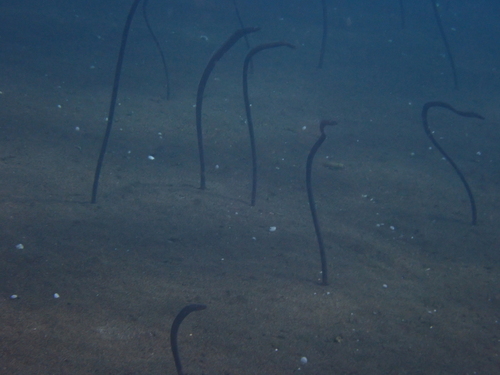
Japanese garden eel
The Bluefin Tuna, a highly migratory species, is one of the ocean's most remarkable predators. Renowned for its size, speed, and commercial value, this fish plays a critical role in marine ecosystems. Its unique physiology allows it to thrive in a wide range of temperatures, making it a truly global species.
2 8 years
Lifespan
80-100 cm
Length
Least Concern
Conservation Status
N/A km/h
Swimming speed
Planktivorous, Filter Feeding
Diet
Sedentary
Migration
Appearance Overview
The Bluefin Tuna is renowned for its large, streamlined body, built for speed and endurance in the open ocean.
Color
Dark metallic blue on top, with a silvery-white underside
Fins
Two dorsal fins, the first depressible; small, yellow finlets run down the back and belly to the tail
Body Shape
Torpedo-shaped, designed for efficient swimming
Length
Up to 13 feet (4 meters), commonly 6.5-8 feet (2-2.5 meters)
Weight
Up to 2,000 lbs (907 kg), commonly 550 lbs (250 kg)
Diet
Carnivorous, feeding on a variety of fish, squid, crustaceans, and occasionally on zooplankton and other small organisms.
Feeding Behavior
Highly active predator, using its speed and agility to hunt. Bluefin tuna often hunt cooperatively, herding prey into tight groups before striking.
Social Behavior
Highly migratory, known to form schools, sometimes segregated by size. They can travel vast distances across oceans for feeding and spawning.
Commercial Relevance
Extremely high value, especially in sushi and sashimi markets, where its fatty flesh is considered a delicacy. Overfishing has significantly impacted its market price and availability.
Conservation measures
International fishing quotas, catch limits, and monitoring programs. Efforts also include promoting sustainable aquaculture practices and establishing marine protected areas.
Status
Varies by species: Atlantic Bluefin - Endangered; Pacific Bluefin - Vulnerable; Southern Bluefin - Critically Endangered
Threats
Overfishing is the primary threat, driven by high demand in the sushi market. Other threats include bycatch in fishing gear, habitat degradation, and climate change.
Habitat Distribution
Depth Range
Surface waters to depths of over 3,000 feet (1,000 meters), depending on the species and time of year
Geographic Range
Atlantic Bluefin: Western and Eastern Atlantic, Mediterranean Sea; Pacific Bluefin: North Pacific Ocean; Southern Bluefin: Southern Hemisphere oceans
Preferred Environment
Open ocean (pelagic), but also found in coastal waters. They prefer temperate and subtropical waters.
Reproduction and Life Cycle
Breeding Habits
Spawns in specific areas, such as the Gulf of Mexico and the Mediterranean Sea for Atlantic Bluefin. Spawning typically occurs in warm waters during specific seasons.
Development Stages
Eggs are pelagic (free-floating). Larvae develop rapidly, feeding on plankton. Juveniles grow quickly, eventually transitioning to a diet of fish and other larger prey.
Fecundity
Females are highly fecund, capable of releasing millions of eggs (up to 30 million) during a single spawning season.
Maturity Age
Varies by species; Atlantic Bluefin typically mature at 4-8 years, while Southern Bluefin mature later, around 8-12 years.
Faqs about Japanese garden eel
How long do Bluefin Tuna live?
The lifespan can vary, but they generally live up to 15-30 years in the wild, with some individuals reportedly living longer.
Where can I find Bluefin Tuna?
Bluefin Tuna are found in the Atlantic, Pacific, and Indian Oceans, as well as the Mediterranean Sea. They are highly migratory and can travel long distances.
Can I eat Bluefin Tuna?
Yes, but it's crucial to choose tuna from sustainable sources. Check seafood guides and certifications to ensure you're making an ocean-friendly choice.
How fast can Bluefin tuna swim?
Bluefin tuna are among the fastest fish in the ocean, capable of reaching speeds up to 43 mph (70 km/h) in short bursts.
How do Bluefin Tuna stay warm in cold water?
They have specialized blood vessels that act as a counter-current heat exchange system, allowing them to maintain a body temperature higher than the surrounding water.
What are the predators of Bluefin Tuna?
Besides humans, Bluefin Tuna's main predators include sharks, orcas (killer whales), and other large marine predators.
Copyright @ Nature Style Limited. All Rights Reserved.
 English
English